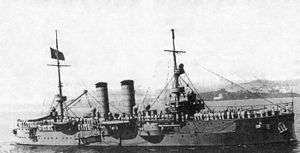Portuguese ironclad Vasco da Gama
 Vasco da Gama, in the early 20th century | |
| History | |
|---|---|
| Name: | Vasco da Gama |
| Namesake: | Vasco da Gama |
| Builder: | Thames Iron Works, Blackwall, London |
| Laid down: | 1875 |
| Launched: | 1 December 1876 |
| Completed: | 1878 |
| Fate: | Broken up in 1935 |
| General characteristics | |
| Displacement: | 2,384 t (2,346 long tons; 2,628 short tons) |
| Length: | 200 ft (61 m) pp |
| Beam: | 40 ft (12 m) |
| Draft: | 19 ft (5.8 m) |
| Installed power: | 3,000 ihp (2,200 kW) |
| Sail plan: | Barquentine rig |
| Speed: | 10.3 knots (19.1 km/h; 11.9 mph) |
| Complement: | 232 men |
| Armament: |
|
| Armor: |
|
Vasco da Gama was a central battery ironclad which entered service with the Portuguese Navy in 1876, serving until 1935. She was built by the Thames Iron Works in London, launched in 1876, and completed in 1878. She served as the flagship of the Portuguese fleet for the majority of her long and peaceful career. She was rebuilt and heavily modernized between 1901 and 1903. Long-since obsolete by the 1930s, Vasco da Gama was finally sold for scrapping in 1935.
Design
Vasco da Gama was 200 feet (61 m) long between perpendiculars, and she had a beam of 40 ft (12 m), though at the main battery guns, the ship was 46 ft 6 in (14.17 m) wide. She had a maximum draft of 19 ft (5.8 m). She displaced 2,384 metric tons (2,346 long tons; 2,628 short tons) as originally built. She was fitted with a barquentine rig and a steam engine rated at 3,000 indicated horsepower (2,200 kW), which produced a top speed of 10.3 kn (19.1 km/h; 11.9 mph). She had a crew of 232 officers and men.[1]
As built, Vasco da Gama was armed with a main battery of two 10.2 in (260 mm) guns, placed in individual barbettes side by side amidships. She was also equipped with a single 5.9 in (150 mm) gun mounted on her stern, and four 9-pounder guns for close-range defense against torpedo boats. She was protected with a complete iron armored belt that was 4 inches (100 mm) thick on either end and 9 in (230 mm) thick amidships. The main battery guns were protected by 10-inch (250 mm) thick barbettes.[1]
Service history
Vasco da Gama was laid down at the Thames Iron Works shipyard in London, Britain in 1875,[1][2] and was launched on 1 December 1876.[3] The ship was completed in 1878.[4] She served as part of the coastal defense force that protected Lisbon, the Portuguese capital, and the mouth of the river Tagus.[1][5] On 26 June 1897, Vasco da Gama participated in the Fleet Review at Spithead celebrating Queen Victoria's Diamond Jubilee. At the time, the ship was commanded by Captain Barreto de Vascomellos.[6]

In 1901, Vasco da Gama was taken into drydock at Orlando shipyard in Livorno, Italy, for a major reconstruction. She was cut in half and lengthened by a 32 ft 6 in (9.91 m) long section. She was fitted with new engines and more powerful water-tube boilers rated at 6,000 ihp (4,500 kW); this increased her speed to 15.5 kn (28.7 km/h; 17.8 mph). Her sailing rig also was removed. Her main battery guns were replaced with new 8 in (200 mm) L/40 guns in sponsons, the short 5.9-inch gun was replaced by a new long-barreled 5.9-inch L/45 gun, and six 3-pounders augmented her close-range defense. Her iron belt armor was removed and stronger steel armor was installed in its place. The ship's crew increased to 260 officers and men. All of the changes caused her displacement to rise to 2,972 metric tons (2,925 long tons; 3,276 short tons). Work on Vasco da Gama was completed by 1903.[1]
On 27 August 1907, a gas explosion aboard the ship injured several crewmen.[7] During political unrest in April 1913, part of the crew of Vasco da Gama had to be removed from the ship, as they had been involved in a planned ultra-Radical coup d'état against the First Portuguese Republic. On 14 May 1915, the crew again participated in unrest; they mutinied and killed the ship's captain and bombarded Lisbon, killing around one hundred people.[8] Vasco da Gama remained the flagship of the Portuguese Navy at least as late as 1914, as the Portuguese naval budget was insufficient to fund a suitable replacement vessel.[9] Thoroughly obsolete, she remained in the Portuguese fleet until 1935, when she was sold for scrapping.[3]
Notes
References
- Brassey, Thomas A., ed. (1905). Brassey's Naval Annual. Portsmouth, UK: J. Griffin & Co. Missing or empty
|title=(help) - Chisholm, Hugh, ed. (1912). The Encyclopædia Britannica. XXXII. London: Encyclopædia Britannica.
- Gardiner, Robert, ed. (1979). Conway's All the World's Fighting Ships: 1860–1905. London: Conway Maritime Press. ISBN 0-85177-133-5.
- Gardiner, Robert; Gray, Randal, eds. (1984). Conway's All the World's Fighting Ships: 1906–1922. Annapolis: Naval Institute Press. ISBN 0-87021-907-3.
- "Ironclads Vasco da Gama and Andes". Warship International. Toledo, Ohio: Naval Records Club. X (1): 106–08. 1973.
- Mason, Herbert B., ed. (1908). Encyclopaedia of Ships and Shipping. London: The Shipping Encyclopedia Ltd.
- Notes on Naval Progress. Washington, DC: Government Printing Office. January 1898. Missing or empty
|title=(help) - Palmer, W., ed. (1908). Hazell's Annual. London, UK: Hazell, Watson & Viney, LD. Missing or empty
|title=(help) - Paloczi-Horvath, George (1996). From Monitor to Missile Boat: Coast Defence Ships and Coastal Defence Since 1860. London: Conway Maritime Press. ISBN 0-85177-650-7. line feed character in
|title=at position 30 (help)
External links
| Wikimedia Commons has media related to Vasco da Gama (ship, 1875). |